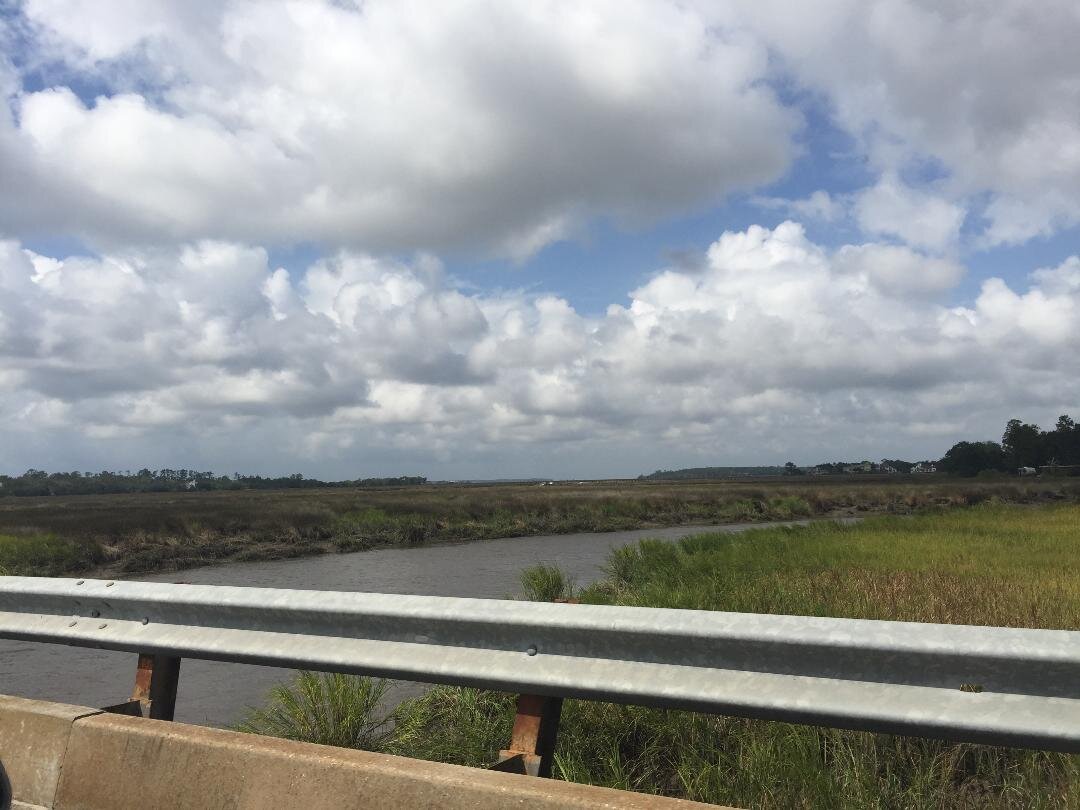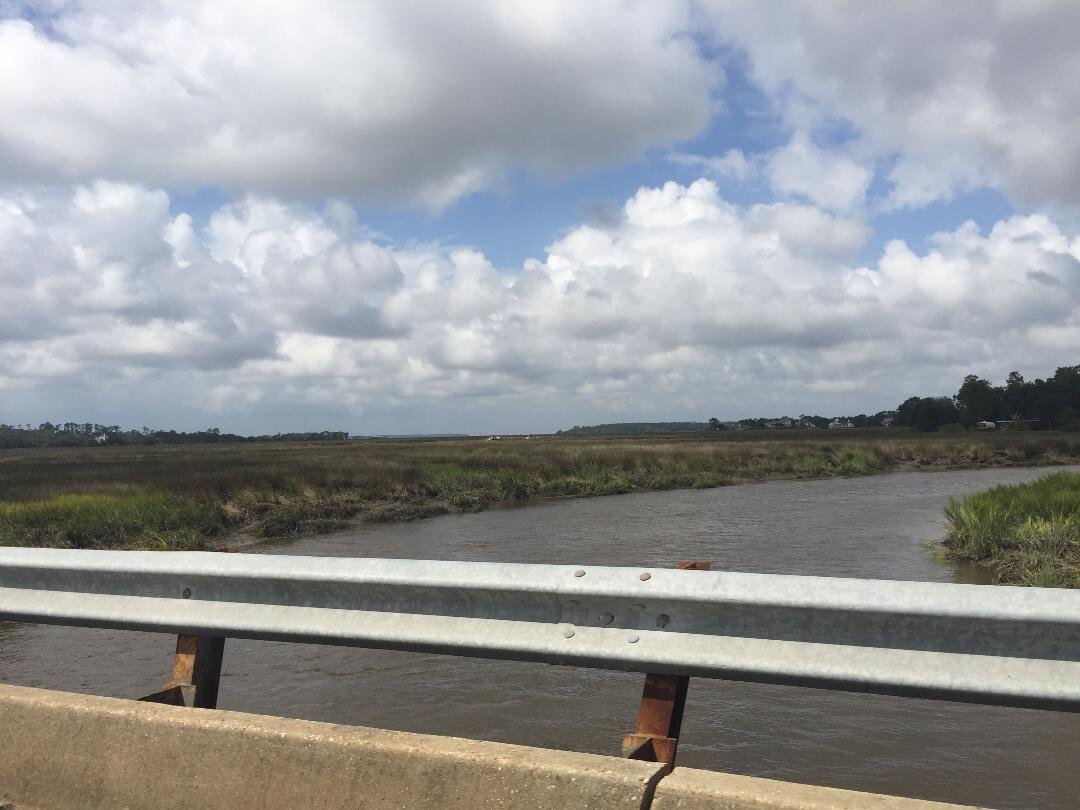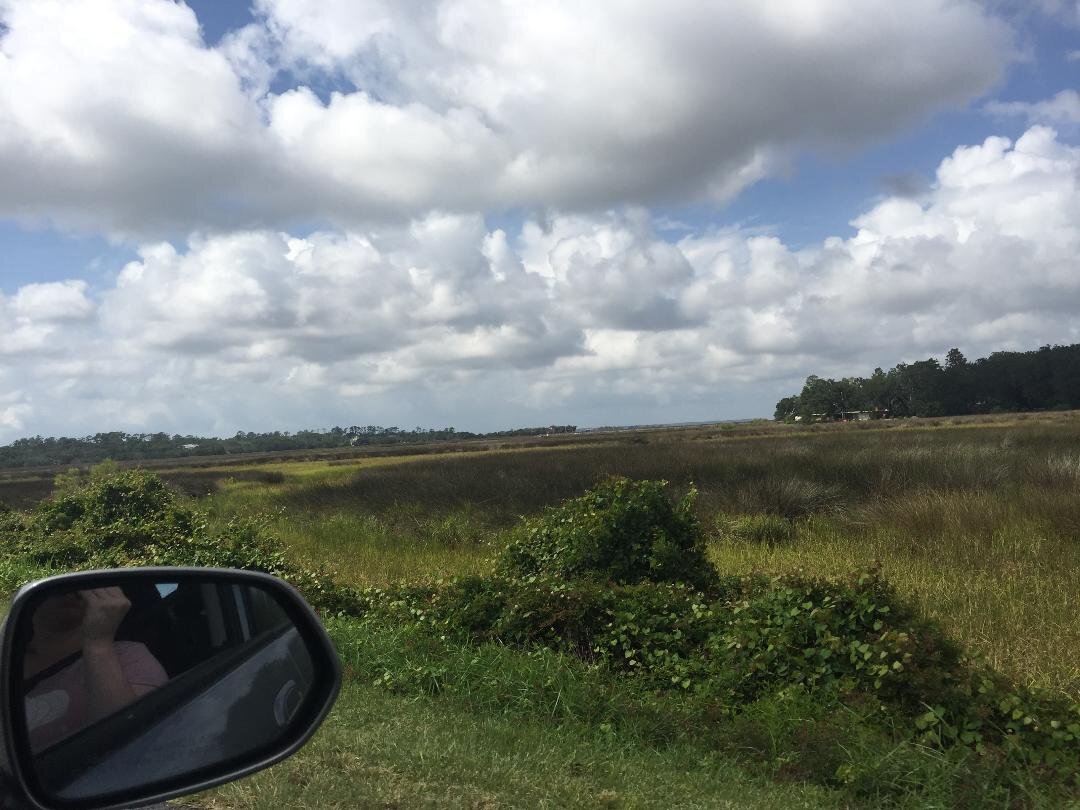My husband and I celebrated our anniversary in September by spending a weekend just down the coast on Saint Simon’s Island. Aside from strolling along the beach, there are a number of historical sites we were interested to visit. Some significant places, though, remain inaccessible, unmarked and hardly acknowledged. For example:
The small selection of photos up above is the closest I was able to get to a site known as Igbo (or Ebo) Landing. This is the view as you take Sea Island Road across Dunbar Creek. Sadly, there is no access to the actual landing because it is located on private property. There isn’t even a historical marker, which I think is a real shame.
What is Igbo Landing and why is it important? I didn’t know anything about the event that took place there 217 years ago, had never heard of it at all until I was in my 30s. A friend of mine stumbled across the information, on Tumblr of all places, and was thoughtful enough to text it to me. (Thanks, Shelley!) I felt stupid for not knowing about something that I’ve since realized is woven throughout Low Country cultural memory. So, here I am, trying to save you from feeling just as stupid.
In May of 1803, about 75 Igbo tribespeople who had been captured in what is now Nigeria were purchased in Savannah, then shipped down the coast to work on plantations belonging to John Couper and Thomas Spalding. They staged a mutiny during the voyage, drowned the crew, and grounded the boat in Dunbar Creek on Saint Simon’s Island. Knowing they had no way home and no hope of freedom in this strange land, they walked into the creek (singing a song of their native country, according to some accounts) and committed mass suicide by drowning. It is unclear how many died (at least a dozen), how many vanished, and how many were “salvaged” by slave catchers.
This heroic act of resistance has been rippling through the memory of Black America ever since. It is believed to have given rise to “the myth of the flying Africans” which pervaded regional African American folklore well into the 20th century. It is still being retold to this day, as in the children’s book The People Could Fly: American Black Folktales by Virginia Hamilton. It’s also referenced in works by Toni Morrison, Alex Haley and a variety of other African American writers. Stories about enslaved people flying right back home to Africa turn up again and again among the people interviewed for the book Drums and Shadows: Survival Stories Among the Georgia Coastal Negros. As part of the Works Progress Administration during the 1930s, the Savannah Unit of the Georgia Writers Project conducted interviews with dozens of Black people- from Yamacraw here in town all the way down the coast to St. Mary’s. Some of them were old enough to remember having been enslaved. The stories were published in 1940. This quote, from page 79 of the paperback edition, gives you an idea how the legend was usually transmitted:
“Muh gran say ole man Waldburg down in St. Catherine own some slabes wut wuzn climatize an he wuk um hahd an one day dey wus hoein in duh fiel an duh dribuh come out an two ub um wuz unuh a tree in duh shade, an duh hoes wuz wukin by demsef. Duh dribuh say ‘Wut dis?’ an dey say, ‘Kum buba yali kum buba tambe, Kum kunka yali kum kunka tambe,’ quick like. Den dey rise off duh groun an fly away. Nobody ebuh see um no mo. Some say dey fly back tuh Africa. Muh gran see dat wid he own eye.”
The flying African myth gets told again by characters in the Julie Dash film Daughters of the Dust. I watched that last year when it was streaming on Netflix, but it’s not available on that platform anymore. You can rent it on Amazon, though. Daughters of the Dust is steeped in Georgia coastal folklore and historical experience. The movie depicts the moment in time when a lot of old Black communities uprooted themselves from the islands, Ossabaw especially, and formed new communities on the Savannah mainland. The hurricanes of 1893 and 1898 had just been too traumatizing for island-dwellers. The new hamlets they formed became Sandfly, Montgomery, and Pin Point. You can visit those neighborhoods to this day. I enthusiastically recommend a visit to the Pin Point Heritage Museum.
And finally, reference to the suicide at Igbo Landing appeared in American cinema in 2018 with Killmonger’s last line in Black Panther: “Bury me in the ocean with my ancestors that jumped from ships because they knew death was better than bondage.” So, you’ve encountered the Igbo suicide before, even if you didn’t realize it.
As I said at the top, there is no marker or access. Just a quick view down the creek as one crosses the bridge. However, there was a ceremony in 2017 to commemorate the people who chose death over enslavement. The Brunswick News has the article. Larry Hobbs asserts the tale of Igbo defiance is well known even in Nigeria. Several Igbo tribal leaders came to Georgia and conducted a ceremony to lay the spirits of the dead to rest there at Dunbar Creek.
Finding out about the mass suicide at Igbo Landing enacted a permanent change on the way I view African American history. It wasn’t necessarily because of the story itself, but because I learned about it after the 2016 election. I was in the frame of mind where the notion of “resistance” resonated with a new intensity. As I read about the event I thought to myself, “How bold and poignant! Suicide as resistance against oppression!” Suddenly a hallway lit up in my brain which led me to a new perspective. For the first time I consciously thought of enslaved people as people who actively resisted their condition.
It wasn’t that I ever thought folks liked being enslaved. The problem is the way American history was taught to me. I don’t even mean to say I had teachers who were slavery apologists or anything like that. I’m talking about well-meaning and smart teachers who I wish had connected a few dots for me when I was much younger. They taught me about the Stono Rebellion, Denmark Vessey, Nat Turner, etc. They taught me that sometimes slaves would pretend to be stupid or sick or to have broken their tools in order to get out of work. I’ve done plenty of reading on my own and know that slaves would sometimes run away only to catch a break for a little while, not with the intention of staying gone forever. I know slave owners complained constantly about how black people always “dissembled” around white people (as if being honest with white people were ever a safe option for them). People did teach me these things. I did learn these things. But I learned of them as distinct events, individual occurrences.
The shortcoming in my education was that no one ever connected all of it for me into an ongoing narrative of active resistance. I understand now that I was left with an impression of enslaved Africans as passive about their fate. It was very subtle and entirely unconscious and I’m sure it’s a problem that afflicts most white people in America and probably a fair number of Black people as well. Why does it matter? I have found this shift in perspective to be absolutely vital. We relate differently to people we perceive as having fought for something versus people we perceive as having been given something. If white folks in America walk around with the vague impression that enslaved people were too downtrodden or indifferent or (ugh) satisfied with their situation to fight for their own freedom, then it allows for the insidious sensation that African Americans today should be grateful for their “rescue” via the Civil War and that white people did all the work for them.
But the truth is Black people were always doing the work. Occasionally in big ways with an outright rebellion, but mostly in a thousand small ways. They ran away temporarily, or broke their tools, or feigned illness to steal back just a little bit of their own time. They fled and formed maroon colonies deep in swamps where nobody could get to them. They had side-hustles to earn cash, on top of being enslaved 24/7. They ran secret schools at the risk of being imprisoned or whipped. Most conductors on the Underground Rail Road were Black. Freedmen set money aside to purchase their loved ones. Enslaved people set money aside to purchase themselves. They defied the law by staying out beyond curfew or drinking in taverns. They tried to make use of the law for their own sake, as was the case with Dred Scott. The list goes on and on.
Armed defiance is not the only type of defiance that matters. And we all know every major act of armed rebellion in American history ended very badly for the slaves conducting it. Enslaved Africans in America were never passive about their situation; they were just badly, badly outgunned. But they were always working for their own liberation and survival and success. They were not “given” their freedom in 1865. They had been fighting for it constantly since 1619. White kids educated in public schools like me just have a hard time seeing that because so much of what they did was necessarily in secret or it’s not included in our curriculum or it’s depicted unflatteringly from their owners’ point of view or, sometimes, it’s just not all linked together in a meaningful way.
This is the difference learning about Igbo Landing has made in my life. I knew facts before, all scattered and separate from each other. But now they have come together like pixels on a computer screen resolving into an image I can actually see. I was missing this insight for my whole life. I hope now it will improve your understanding as you go forward and you’ll have the head start I did not.


